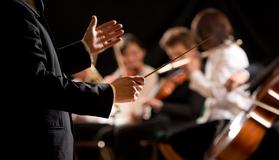-
1 阅读
-
2 阅读
-
3 阅读
-
4 阅读
 Introduction to Rhythm
Introduction to Rhythm
节奏介绍
Musical Time: Introduction to Rhythm
音乐时间:节奏介绍
Listento the opening of Handel's "He trusted in God" from the Messiah.Ignore for the time being the particular pitch-aspects of the passage (e.g.that it begins with a falling fifth, that it starts on G, etc.) and try tofocus only on the organization of those events as they unfold in time.
听来自于Handel的Messiah的“他相信上帝”的开幕,忽略乐段特定的音调方面(例如,它开始于下降的五度,它开始于G等),努力集中在按时间展开的这些事件的组织上。
Example9. Handel, "He trusted in God."
例9. Handel,“他相信上帝”。

What can we observe about the passage?
我们可以从该乐段中发现什么呢?
One thing you may have noticed is that somenotes last longer than others. For example, the opening two notes on syllables"He trust-" are longer than the next four notes on the syllables"-ed in God that." Some even shorter notes happen on the word"would." This aspect of musical time concerns the relative durationsof notes. Rhythm is the musical term often used to describe a particular seriesof durations, although rhythm also has a broader meaning, as we shall seeshortly, that encompasses more than just duration.
有一件事你可能已经注意到,有些音符比其他的要持续更久。例如,关于“He trust-”音节的开头两个音符,要比接下来的四个音节“-ed in God that.”要长。“would”这一词的音符有些甚至更短。音乐时间的这个方面涉及音符的相对持续时间。节奏是经常被用来描述特定的一系列持续时间的音乐术语,虽然节奏也具有更广泛的含义,正如我们将要看到的那样,它不仅包含持续时间。
Can you snap your fingers to the excerpt?Start snapping on the first three syllables "He trust-ed" and see ifyou can keep snapping evenly at that speed. Do your continuing snaps sometimesline up with syllables as their sung (snapping always on he, -liv and him) butmiss others (never snapping on de-, -ver, let). If so, your fingers (and yourmusical intuition) found the beat, a steady pulse that underlies musical works(and can also rise to the surface, especially in dance music).
Finally, did you notice that some words andsyllables receive greater emphasis than others? The syllable "trust"is more emphatic that the subsequent syllable "-ed." The syllable"-liv-" in "deliver" is more emphatic than the syllable"him," even though all these syllables happen on the beat. Thisaspect of musical time, the regular emphasis of some beats over others, iscalled meter. Musical meter is intimately related to poetic meter.Consequently, we will draw on examples of poetic verse and familiar nurseryrhymes as we discuss musical time.
你可以用你的手指捕捉片段吗?开始捕捉前三个音节“He trust-ed”,看看你是否能以这样的速度保持均匀的捕捉。你的持续捕捉有时候会跟着他们唱的音节(捕捉的总是he, -liv 和him),但是却错过了其他的(没有捕捉到de-, -ver, let)。如果是这样,你的手指(和你的音乐直觉)就找到了节拍,一个稳定的脉冲,这是音乐作品的基础(也可以上升到表面,特别是在舞曲中)。
最后,你有没有注意到有些词和音节比其他的更受强调?音节“信任”更强调后面的音节“-ed”。即使所有这些音节都发生在节拍上,“deliver”中的音节“-liv-”比音节“him”更受强调。音乐时间这方面,一些节拍的规律性强调,就是格律。音乐格律与诗的格律密切相关。因此,在我们讨论音乐时间时,我们将借鉴诗歌和熟悉的童谣例子。
Rhythm in a more general sense referscollectively to all these aspects of musical time--to series of durations heardwithin a particular metrical scheme. The following sections explore in moredetail these individual aspects of rhythm--the beat, duration, meter--andintroduce some conventions of rhythmic notation.
更一般意义上的节奏是指音乐时间的所有这些方面 - 在特定的格律中所听到的一系列持续时间。下面的章节将更详细地探讨这些节奏的各个方面 - 节拍,持续时间,格律 - 并介绍一些节奏符号的约定。











